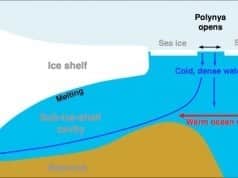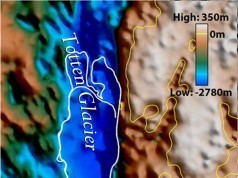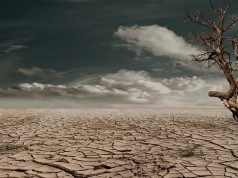Two years ago the Los Angeles Times flew reporter Julie Cart all the way to Australia so she could write an article titled What will global warming look like? Scientists point to Australia.
At the top of the web version of the story there’s a short video in which Tim Flannery (described as a “scientist and climate change expert”) says that Australia’s “new climate” is a result of climate change. The human-induced nature of that change is simply assumed.
Flannery says Australia is now “significantly drier” and “significantly hotter.” He says his country is experiencing “longer droughts and hotter droughts,” then he admits it also experiences flooding. Both of these, he adds, “are not inconsistent with climate change.”
Now unless this Canadian is misunderstanding matters, the entire history of Australia involves alternating floods and droughts. Which means, of course, that what’s happening now is not inconsistent with long-established, perfectly natural weather trends.
But let’s not dwell on that last point since anyone who does will immediately conclude there’s no news story here. And Cart, an environmental reporter, has written a 2,300-word feature insisting otherwise.
So how does she build her case? She describes the terrible plight of a farmer whose orchard has suffered a decade-long drought. She tells us about the desperation of his neighbours. Then she asks the rhetorical question: “A result of climate change?”
Implying that the opinion of one demoralized farmer settles the question, she then quotes him saying: “You’d have to have your head in the bloody sand to think otherwise.”
Moving right along, Cart tells us:
Climate scientists say Australia.epitomizes the “accelerated climate crisis” that global warming models have forecast.
When she introduces us to Flannery, she describes him as a paleontologist who is “Australia’s most vocal climate change prophet.” In other words, he’s an activist scientist. We know this because he doesn’t restrict himself to the cautious, careful language one would expect from a professional scientist. Instead, he tells us this about climate change:
We are already starting to see it. It’s tearing apart the life-support system that gives us this world.
Readers are then told that many Australians believe there’s a link between climate change and the bushfires that tragically claimed 200 lives in early 2009. We’re advised that a royal commission is investigating this question and that nothing can be said for certain. Nevertheless Cart tells us one more time that:
veteran firefighters, scientists and residents believe the case has already been made. [emphasis added]
(When the commission released its report three months later, the 8-page concluding chapter [available here] did not contain the terms “climate” or “global warming.” Rather, the commission said the fires were started directly or indirectly by human beings – one accidentally, four under suspicious circumstances, and five due to a “failure of electricity assets.” A sudden change in the wind also caused significant problems.)
Cart turns her attention to a four-day-long heat wave, and the human and wildlife deaths associated with it. Now remember, weather is not climate – unless it’s a heatwave that’s being used to prove that global warming is upon us. In which case reporters such as Cart will quote firefighters making dramatic pronouncements:
Something is happening in Australia. Global warming is no longer some future event that we don’t have to worry about for decades. What we have seen in the past two weeks moves Australia’s exposure to global warming to emergency status.
Cart also introduces us to Chris Cocklin, describing him as:
a climate change researcher.and lead author on the latest report from the Intergovernmental Panel on Climate Change.
Cocklin was, indeed, one of 12 lead authors for one of the 44 chapters of the 2007 IPCC climate bible. His chapter was titled Sustainable development and mitigation (Working Group 3, Chapter 12). A citizen audit I coordinated last year gave that chapter an F. We discovered that only 37% of the reference material on which it depends is peer-reviewed – despite claims by the IPCC’s chairman that the report is based solely on peer-reviewed sources.
Cocklin, the former head of the Geography and Environmental Science department in the arts faculty of Monash University, is quoted by Cart speculating on the political implications should the above-mentioned royal commission find a climate change link. We also get to hear his views on the relationship between coal mining and Australia’s Labour Party. In other words, there’s little in this news story that seems connected to Cocklin’s academic expertise.
With no sense of irony, Cart compares Australia’s (allegedly human-caused) drought to the perfectly natural 1930s Dust Bowl experience in America. She tells us:
Australia is witnessing the collapse of its agricultural sector and the nation’s ability to feed itself.
She informs us that, near the agricultural community of Shepparton, Victoria “annual rainfall used to be 19 to 21 inches a year.” Then she quotes a farmer who says: “Now we’re lucky if we get 6 to 7 inches”.
Unfortunately for the farmer – and for Cart – there’s an airport in Shepparton that records annual rainfall. According to official government data, far more rain fell during the five years prior to her story’s appearance than she suggests:
- 2004 – 15 inches (380 mm)
- 2005 – 21 inches (543 mm)
- 2006 – 7 inches (183 mm)
- 2007 – 14 inches (354 mm)
- 2008 – 17 inches (432 mm)
- 2009 – 13 inches (321 mm)
One year after Cart used Shepparton as a parched, global warming poster-child the area received a full 30 inches (770 mm) of rain.
In other words, the farmer got it wrong. 2006 was an especially dry year in Shepparton. During that one year only 7 inches of rain fell. But the mean amount of rainfall since 1996 has actually been 17 inches. Not 19 to 21. And not 6 to 7. Cart didn’t fact-check the veracity of the farmer’s quote and neither did her editor.
Nor did Cart mention that, according to a local government website, Shepparton experienced floods in 1974 and 1993. Despite her clear suggestion that global warming would make things drier still, 17 months after her news story appeared, Shepparton experienced flooding yet again (in September 2010).
Moreover, despite the article’s overall suggestion that temperatures would continue to trend high, Australia currently enjoys diverse weather. Just last month the western part of the country experienced a Christmas-time heat wave while the eastern coast shivered under a “bitter summer freeze” that included snowfall.
So does global warming look like Australia? The smart answer to that question is: Don’t believe everything you read in the Los Angeles Times.
h/t to Christopher Hanley, in the comments at WattsUpWithThat.com for alerting me to the LA Times article





